
Boronia molloyae, commonly called the tall boronia, is a plant in the citrus family that is endemic to coastal regions in the south-west of Western Australia. It is a shrub with pinnate leaves that mostly have between three and seven leaflets, and deep rose pink, four-petalled flowers. It usually grows along streams in sandy soil.

Cyanothamnus baeckeaceus is a plant in the citrus family, Rutaceae and is endemic to eastern Australia. It is a slender or straggling shrub with simple or trifoliate leaves and pink and white four-petalled flowers. It is endemic to the south-west of Western Australia.

Cyanothamnus coerulescens, commonly known as blue boronia, is a plant in the citrus family, Rutaceae and is endemic to southern Australia. It is a small, spindly shrub with glandular stems, small, more or less cylindrical leaves and blue to pinkish mauve, four-petalled flowers. There are two subspecies endemic to Western Australia and a third that also occurs in three eastern states.
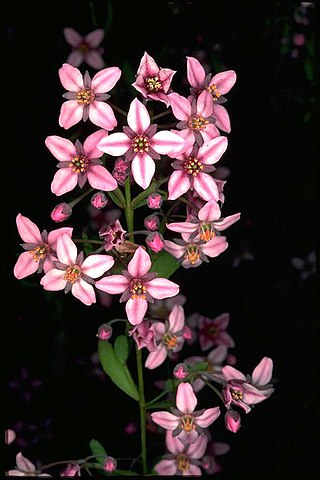
Boronia fastigiata, commonly known as bushy boronia, is a plant in the citrus family, Rutaceae and is endemic to the south-west of Western Australia. It is an erect shrub with small leaves and small groups of red, pink or purple, four-petalled flowers near the ends of the branches.
Cyanothamnus acanthocladus is a plant in the citrus family, Rutaceae and is endemic to a small area in the south-west of Western Australia. It is a low, prickly shrub with small leaves and white, four-petalled flowers.

Boronia anceps is a plant in the citrus family, Rutaceae and is endemic to a small area in the south-west of Western Australia. It is a perennial herb with small leaves and pink, four-petalled flowers.
Boronia coriacea is a plant in the citrus family, Rutaceae and is endemic to a small area in the south-west of Western Australia. It is a small shrub with pinnate leaves and hairless pink, four-petalled flowers in small clusters on the ends of the branches.

Boronia capitata, commonly known as the cluster boronia, is a plant in the citrus family, Rutaceae and is endemic to the south-west of Western Australia. It is a slender, spreading shrub with simple leaves and pink, four-petalled flowers.

Boronia dichotoma is a plant in the citrus family, Rutaceae and is endemic to the south-west of Western Australia. It is an erect, slender perennial herb or shrub with simple leaves and pink, four-petalled flowers. The species is characterised by sticky glandular hairs on the pedicels.
Boronia exilis is a plant in the citrus family, Rutaceae and is endemic to a small area in the south-west of Western Australia. It is a slender, erect perennial with well-spaced, simple, more or less cylindrical leaves and pink, four-petalled flowers in groups of between three and nine on the ends of the branches.
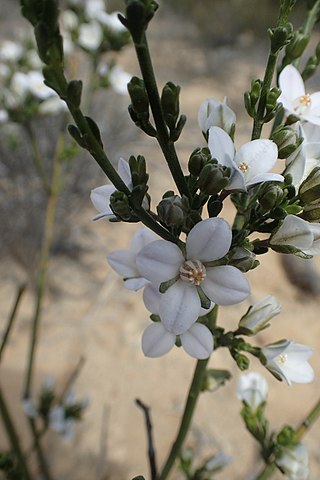
Cyanothamnus fabianoides is a plant in the citrus family, Rutaceae and is endemic to the south-west of Western Australia. It is a compact shrub with many branches, simple, more or less cylindrical leaves and single white, pink or pale blue four-petalled flowers in the leaf axils.
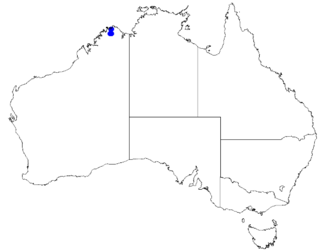
Boronia kalumburuensis is a plant in the citrus family Rutaceae and is endemic to the Kalumburu area of Western Australia. It is an erect or sprawling shrub with many branches, pinnate leaves and white to pink four-petalled flowers with the sepals longer and wider than the petals.
Boronia minutipinna is a plant in the citrus family Rutaceae and is endemic to a small area in the Kimberley region of Western Australia. It is an erect shrub with many branches, hairy stems and leaves, pinnate leaves and white to pink, four-petalled flowers with the sepals longer and wider than the petals.

Boronia pauciflora is a plant in the citrus family Rutaceae and is endemic to the Kimberley region of Western Australia. It is an erect shrub usually with simple leaves and white to pink, four-petalled flowers.
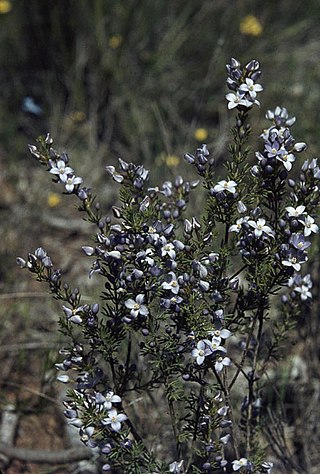
Cyanothamnus ramosus is a species of plant in the citrus family Rutaceae and is endemic to the southwest of Western Australia. It is an erect, mostly glabrous shrub with pinnate leaves with up to seven leaflets, and white, four-petalled flowers with blue or pale green backs.

Boronia revoluta, commonly known as Ironcap boronia, is a plant in the citrus family, Rutaceae and is endemic to the south-west of Western Australia. It is an erect shrub with three-part leaves and pink or white, four-petalled flowers.
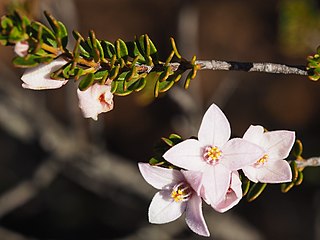
Boronia scabra, commonly known as rough boronia, is a plant in the citrus family, Rutaceae and is endemic to the south-west of Western Australia. It is an open shrub with simple, often clustered, oblong to elliptic leaves, and pink, mostly four-petalled flowers.
Boronia tetragona is a species of plant in the citrus family, Rutaceae, and is endemic to a small area of the southwest of Western Australia. It is an erect, glabrous, perennial herb with simple, sessile leaves and pink, four-petalled flowers.
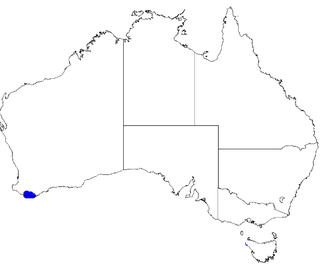
Boronia virgata is a plant in the citrus family, Rutaceae and is endemic to the south coast of Western Australia. It is a virgate shrub with pinnate leaves with between three and five leaflets, and flowers with red sepals and deep pink, egg-shaped petals.

Cyanothamnus westringioides is a species of erect shrub that is endemic to a small area in the southwest of Western Australia. It has simple, narrow, sessile leaves and pale pink flowers arranged singly in leaf axils.
















